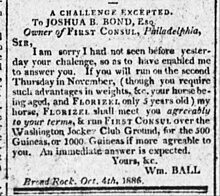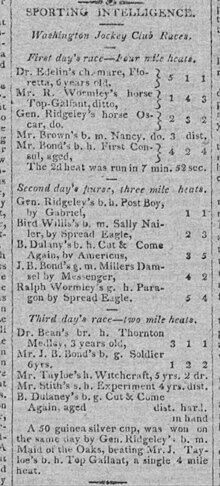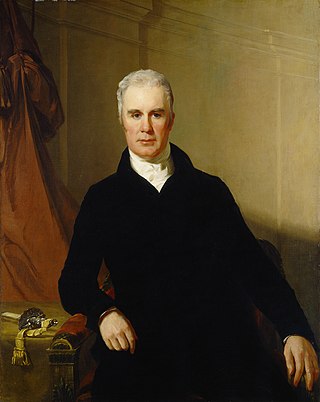
Charles Carnan Ridgely was born Charles Ridgely Carnan. He is also known as Charles Ridgely of Hampton. He served as the 15th Governor of the state of Maryland in the United States from 1815 to 1818. He also served in the Maryland House of Delegates from 1790 to 1795, and in the Maryland State Senate from 1796 to 1800. Charles was born in Baltimore. He was the son of John Carnan and Achsah Ridgely, sister of Captain Charles Ridgely. The Maryland Gazette described him as an aristocrat.

Fair Grounds Race Course, often known as New Orleans Fair Grounds, is a thoroughbred racetrack and racino in New Orleans, Louisiana. It is operated by Churchill Downs Louisiana Horseracing Company, LLC.

Lexington was a United States Thoroughbred race horse who won six of his seven race starts. Perhaps his greatest fame, however, came as the most successful sire of the second half of the nineteenth century; he was the leading sire in North America 16 times, and broodmare sire of many notable racehorses.

Boston (1833–1850) was an outstanding Thoroughbred racehorse and a leading sire in North America three times from 1851 to 1853. He started in about 45 races, winning 40, including 15 in succession. Boston was later one of the initial inductees into the Hall of Fame.

Diomed (1777–1808) was an English Thoroughbred race horse who won the inaugural running of the Epsom Derby in 1780. Sold and imported to Virginia, he was subsequently a successful sire in the United States after the American Revolutionary War.

Mount Airy, near Warsaw in Richmond County, Virginia, is the first neo-Palladian villa mid-Georgian plantation house built in the United States. It was constructed in 1764 for Colonel John Tayloe II, perhaps the richest Virginia planter of his generation, upon the burning of his family's older house. John Ariss is the attributed architect and builder. Tayloe's daughter, Rebecca and her husband Francis Lightfoot Lee, one of the only pair of brothers to sign the Declaration of Independence are buried on the estate, as are many other Tayloes. Before the American Civil War, Mount Airy was a prominent racing horse stud farm, as well as the headquarters of about 10-12 separate but interdependent slave plantations along the Rappahannock River. Mount Airy is listed on the National Register of Historic Places as a National Historic Landmark as well as on the Virginia Landmarks Register and is still privately owned by Tayloe's descendants.

Jean-Bernard Xavier Philippe de Marigny de Mandeville (1785–1868), known as Bernard de Marigny, was a French-Creole American nobleman, playboy, planter, politician, duelist, writer, horse breeder, land developer, and President of the Louisiana State Senate between 1822 and 1823.

Sir Archy was an American Thoroughbred racehorse considered one of the best racehorses of his time and later one of the most important sires in American history. He was inducted into the National Museum of Racing and Hall of Fame in the inaugural class of 1955.
Selima was one of the most important Thoroughbred horses of the 18th century and became one of the foundation mares of the American Thoroughbred. She was imported to Maryland between 1750 and 1752 by Benjamin Tasker, Jr.
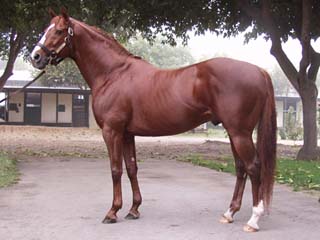
The Thoroughbred is a horse breed developed for horse racing. Although the word thoroughbred is sometimes used to refer to any breed of purebred horse, it technically refers only to the Thoroughbred breed. Thoroughbreds are considered "hot-blooded" horses that are known for their agility, speed, and spirit.

For the Greek statesman of this name, see Timoleon.
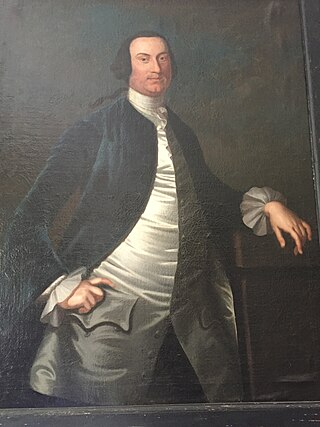
Colonel John Tayloe II was the premier Virginia planter; a politician, and colonial Colonel in the Virginia Militia. Virginia. He served in public office including the Virginia Governor's Council, also known as the Virginia Council of State.
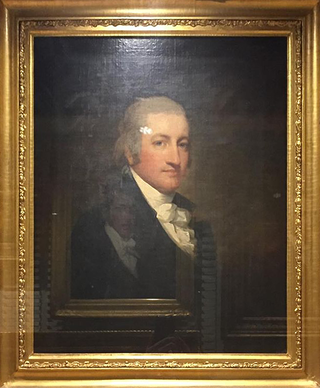
John Tayloe III, of Richmond County, Virginia, was the premier Virginia planter; a politician, businessman, and tidewater gentry scion. He was prominent in elite social circles. A highly successful planter and early Thoroughbred horse breeder, he was considered the "wealthiest man of his day". A military officer, he also served in the Virginia House of Delegates and Senate of Virginia for nine years.
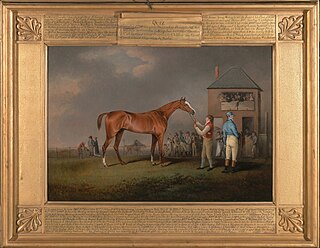
Quiz (1798–1826) was a British Thoroughbred racehorse and sire best known for winning the classic St Leger Stakes in 1801. Quiz was a durable, top-class performer, winning at least once a year in racing career which lasted seven seasons from August 1801 until April 1807. Apart from the St Leger he won many other important races including three Brocket Hall Gold Cups, two Oatlands Stakes at Newmarket Racecourse, a Great Subscription Purse at York, a King's Plate and the Jockey Club Plate. In all he won twenty-one times in thirty-six races for four different owners before being retired to stud, one of which was Mr Hallett Esq, where he proved to be a successful sire of winners.
Horse racing in the United States dates back to 1665, which saw the establishment of the Newmarket course in Salisbury, New York, a section of what is now known as the Hempstead Plains of Long Island, New York. This first racing meet in North America was supervised by New York's colonial governor, Richard Nicolls. The area is now occupied by the present Nassau County, New York, region of Greater Westbury and East Garden City.

Henry Augustine Tayloe of Oakley Plantation, Essex County, Virginia, later Gallion, Canebrake, Alabama, was an American planter, slaveholder, horse breeder and racer, and land speculator in the 19th century.
Leviathan was an American Thoroughbred racehorse considered one of the best horses of the late 1700s and early 1800s. He was also one of the first successful American geldings in racing history with almost every other great horse from that time period either being a stallion or a mare. He also holds the longest winning streak in American racing history winning 23 consecutive races from 1797 to 1801 with at-least 15 of these races being heat races meaning he won at least 38 consecutive heats.
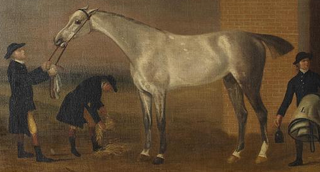
Medley (1776–1792) was a British Thoroughbred racehorse who was imported to the United States after the American Revolutionary War, becoming one of the foundation stallions of the American Thoroughbred.
The Eclipse Race Course was the third formal thoroughbred horse racing track in New Orleans, Louisiana, founded in 1837 by Captain Yelverton Oliver, who owned the famous thoroughbred Richard of York; a native Virginian, who organized The New Orleans Jockey Club.

The Louisiana Jockey Club was an American sporting association founded in 1837 with the completion of the Carrollton Race Course, in New Orleans, Louisiana. Today this is the only remaining Thoroughbred Race Course of the old-line tracks, the others which have closed are the Metairie Race Course, the Eclipse Race Course, and the Jackson Race Course; it exists today as the Fair Grounds Race Course, where races are still held-making it the 2nd oldest continuous racing track in operation in the United States, after the Freehold Raceway and before the Saratoga Race Course.


